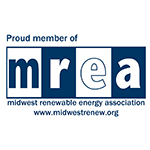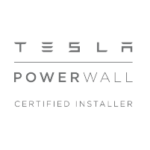Have you been looking into solar and cannot decide whether you want a ground-mounted system or a roof-mounted system? Here’s what you should consider when choosing between array types.
1) Typically roof-mounted arrays are cheaper overall, but if there are many obstructions (dormers, vents, etc) or many roof faces, a ground-mount may be less. For large arrays (over 30 kW) it will depend on the area of roof that you have, how much space you have on the ground and the soil type, and the size of your array. Our project developers can give you recommendations on which type of system generates the greatest return on your investment.
2) Does your jurisdiction allow for ground mounted systems? Typically, ground-mounted arrays are 12 feet high and 10-30 feet long, and it may not be ideal in your neighborhood. Many communities with properties close together do not allow ground mounted systems, because they are high voltage electrical arrays that need space and should be minimally accessible by children, pets, and people.
Our permitting experts understand the permitting jurisdictions in Illinois and Missouri like the back of their hand. So if you are unsure just let us know and we would be happy to look that up for you.
3) If you do have the space on the ground and live in a jurisdiction that allows ground mounted arrays, look to see if that ground area is unobstucted by trees. Having space is one thing, but it is important to consider if you actually produce energy from the array. The ideal ground-mount array will face due south, an east or west facing array will produce about 20% less energy. Putting an array on the ground in the middle of a forest will give you a poor return on investment.
4) Sold on a roofmount now that you know it is generally cheaper? Do you have the roof space (with few obstructions like dormers, vents, etc) that faces south, east or west? Similar to the ground-mounted array, your roof should also have access to the sun for most of the day and should not be significantly shaded by trees, buildings or other large obstructions. A solar panel is about 6 feet tall by 3 feet wide, and there needs to be space to put multiple panels. For safety precautions, there must be room to walk around the array.
5) Finally, consider the age of your roof and the type of shingles. We highly recommend metal roofs for solar. They last an incredibly long time, are easy to install on, and have great warranties. We can also install on standard shingle roofs. However, if your shingled roof is over 15 years old we recommend replacing the roof first. We will not install on roofs that are over 15 years old, because we do not want for you to remove and replace the panels for your new roof shortly after our installation. Remove and replace adds costs to the life of your solar investment.
Other roof types can be more difficult. We typically do not do installations on slate, tile, or wood slate roofs. These solar installations are quite expensive, making the return on investment less than the typical rooftop array.
Is Your Home Good for Solar?
Find out by taking our solar quiz.















